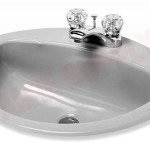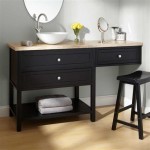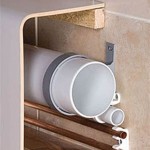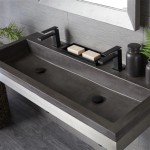How Thick Should a Bathroom Vanity Top Be?
Selecting a bathroom vanity top involves considering several factors, including the material, aesthetics, and functionality. One crucial aspect often overlooked is the thickness. The thickness of a bathroom vanity top significantly impacts its durability, appearance, and overall cost. Determining the ideal thickness requires understanding the strengths and weaknesses of different materials and how they interact with the vanity base and surrounding fixtures.
The purpose of a bathroom vanity top extends beyond merely providing a surface for the sink. It also serves as a workspace for toiletries, a design element contributing to the bathroom's overall style, and a protective layer for the vanity cabinet beneath. The thickness of the chosen material should be sufficient to withstand daily use, resist potential damage from moisture and impacts, and complement the bathroom's design scheme.
Understanding Standard Thicknesses for Different Materials
The appropriate thickness for a bathroom vanity top largely depends on the material used. Common options include granite, quartz, marble, solid surface, and laminate, each with its own recommended thickness for optimal performance.
Granite: Granite is a popular choice due to its durability and natural beauty. The standard thickness for granite vanity tops is typically 3 centimeters (approximately 1 1/4 inches). This thickness provides ample strength to resist cracking and chipping, even with heavy use and the installation of undermount sinks. While thinner granite slabs (2 centimeters) may be available, they often require additional support to prevent breakage, increasing installation costs and complexity. Thicker granite slabs (4 centimeters or more) offer a more substantial appearance and can enhance structural integrity, but they can also be significantly more expensive and heavier, potentially requiring reinforced cabinetry.
Quartz: Quartz is an engineered stone composed of quartz crystals and resin. Like granite, the standard thickness for quartz vanity tops is typically 3 centimeters (approximately 1 1/4 inches). This thickness provides a balance of durability, weight, and cost-effectiveness. Quartz is less porous than granite, making it more resistant to staining and bacteria growth. Thinner quartz slabs (2 centimeters) are sometimes used, particularly in contemporary designs, but they may require additional structural support. Thicker quartz slabs are less common due to cost considerations, as the increased material usage significantly impacts the overall price.
Marble: Marble is a luxurious natural stone known for its elegant veining and smooth surface. The standard thickness for marble vanity tops is generally 3 centimeters (approximately 1 1/4 inches), similar to granite and quartz. However, marble is more porous and softer than granite and quartz, making it more susceptible to staining and scratching. Therefore, proper sealing and maintenance are crucial for marble vanity tops. While thinner marble slabs (2 centimeters) are available, they are generally not recommended for high-use areas due to their increased vulnerability to damage. Thicker marble slabs can enhance durability and provide a more substantial aesthetic, but they also come with a higher price tag and increased weight.
Solid Surface: Solid surface materials, such as Corian and Swanstone, are synthetic materials composed of acrylic or polyester resins and mineral fillers. These materials are non-porous and seamless, making them highly resistant to staining and bacteria growth. Solid surface vanity tops typically have a thickness of 1/2 inch (approximately 1.27 centimeters) or 3/4 inch (approximately 1.9 centimeters). Solid surface materials can be molded into various shapes and designs, allowing for integrated sinks and custom edge profiles. Thicker solid surface tops are often used for a more substantial look or to accommodate integrated sinks with deeper basins.
Laminate: Laminate countertops consist of a thin layer of decorative plastic bonded to a particleboard or MDF core. Laminate is a cost-effective option for bathroom vanity tops, but it is less durable than natural stone or solid surface materials. The typical thickness of laminate vanity tops is 1 inch (approximately 2.54 centimeters) to 1 1/2 inches (approximately 3.81 centimeters). The thickness is primarily determined by the thickness of the core material rather than the laminate layer itself. Laminate is susceptible to water damage, particularly along the edges and seams, so proper sealing and maintenance are essential.
Factors Influencing the Choice of Thickness
Beyond the material type, several other factors influence the optimal thickness of a bathroom vanity top. These factors include the size and configuration of the vanity, the type of sink being installed, the desired aesthetic, and the budget.
Vanity Size and Configuration: Larger vanity tops require greater thickness to prevent sagging or bowing, particularly if they are made of materials like thinner granite or quartz. Longer spans without support are more prone to flexing under weight, which can lead to cracks and structural instability. Vanities with multiple sinks or a substantial overhang may also benefit from thicker tops to distribute weight more evenly and provide greater support. The configuration of the vanity, such as whether it is a single-sink or double-sink model, and its dimensions (width, depth, and height), play a significant role in determining the necessary thickness.
Sink Type: The type of sink being installed impacts the required thickness of the vanity top. Undermount sinks, which are mounted beneath the countertop, require a thicker material to provide adequate support and prevent cracking around the sink cutout. The weight of the sink and the water it holds put stress on the surrounding countertop material. Vessel sinks, which sit on top of the countertop, generally require less thickness since the weight is distributed over a wider area. However, the vanity top still needs to be sturdy enough to support the sink and any items placed around it. Integrated sinks, which are molded directly into the vanity top, require a material that can be seamlessly formed and is thick enough to provide structural integrity for both the countertop and the sink basin.
Aesthetic Considerations: The desired aesthetic can also influence the choice of thickness. Thicker vanity tops create a more substantial and luxurious appearance, while thinner tops can provide a sleek and modern look. Some design styles, such as contemporary or minimalist designs, may favor thinner countertops for their clean lines and understated elegance. Other styles, such as traditional or rustic designs, may benefit from thicker countertops that convey a sense of solidity and craftsmanship. The edge profile of the vanity top can also affect the perceived thickness. A thicker edge profile can make a thinner countertop appear more substantial, while a thinner edge profile can accentuate the sleekness of a thicker countertop.
Budget: The budget is a significant constraint in any bathroom renovation project. Thicker vanity tops generally cost more due to the increased material usage and potentially higher installation costs. Natural stone materials like granite and marble tend to be more expensive than engineered stone or solid surface materials. Laminate is typically the most cost-effective option, but it comes with trade-offs in terms of durability and aesthetics. When considering the budget, it's crucial to balance the desired aesthetic with the practical requirements for durability and longevity. Investing in a slightly thicker countertop made of a durable material can often be a better long-term investment than opting for a thinner, less expensive option that may require replacement sooner.
Installation and Support Considerations
The installation of a bathroom vanity top is as important as selecting the appropriate thickness. Proper installation ensures that the vanity top is securely supported and that the weight is evenly distributed, preventing cracking and other damage. Adequate support is particularly critical for larger vanity tops or those made of thinner materials.
Cabinet Support: The vanity cabinet itself must be sturdy enough to support the weight of the countertop, sink, and any items placed on the surface. Weak or unstable cabinets can lead to stress on the countertop, increasing the risk of cracking or sagging. Ensure that the cabinet is level and properly secured to the wall. If the cabinet is not structurally sound, it may need to be reinforced before installing the vanity top. Internal bracing or additional supports can be added to the cabinet to increase its load-bearing capacity.
Substrate and Underlayment: A substrate, also known as underlayment, provides a smooth and stable surface for the vanity top to rest on. This is particularly important for vanity tops made of thinner materials or those installed over uneven cabinets. Common substrate materials include plywood or MDF. The substrate should be properly attached to the cabinet and be free of any imperfections that could create stress points on the countertop. A thin layer of construction adhesive can be applied between the substrate and the vanity top to provide additional bonding and prevent movement.
Seams and Joints: If the vanity top consists of multiple pieces joined together, the seams must be properly sealed to prevent water damage and ensure a seamless appearance. Use a high-quality sealant that is specifically designed for use with countertops. The seams should be tight and even, with no gaps or overlaps. For natural stone countertops, it is often recommended to have the seams professionally sealed to ensure a durable and aesthetically pleasing result.
Professional Installation: While it may be tempting to install a bathroom vanity top as a DIY project, it is often best to hire a professional installer. Professional installers have the experience and expertise to ensure that the vanity top is properly supported, leveled, and sealed. They can also handle any necessary modifications to the cabinet or plumbing. Professional installation can help to prevent costly mistakes and ensure that the vanity top lasts for many years.

Love A Thick Countertop Home Bathroom Vanity Newfield

Thick White Marble Bath Vanity Countertops Design Ideas

Bathroom Vanity Tops And Sink How To Choose A Countertop

How To Build Protect A Wood Vanity Top Houseful Of Handmade

Thick White Marble Bath Vanity Countertops Design Ideas

Bathroom Vanity With Thick Marble Countertop Transitional

Paint Bathroom Vanity Countertop Sink So Easy A Piece Of Rainbow

Choosing Bathroom Countertops

Sa140201g By Blu Bathworks Series 1400 Bone Vanity Top With Right Offset Basin 1 2 Thick White Gloss 55 4 X 20 Central Plumbing Specialties Grande Showroom

How To Replace A Vanity Top And Save Craving Some Creativity







